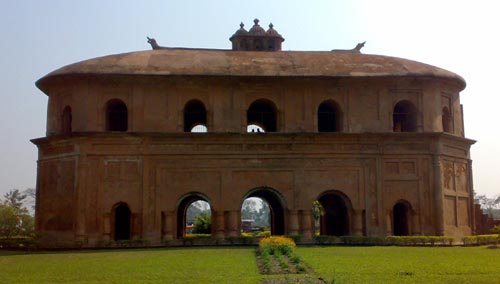Rang Ghar

Information on Rang Ghar (Sivasagar, Assam) - History & Architecture
Rang Ghar of Ahom dynasty which is often regarded as Colosseum of the east is an oldest amphitheater within entire Asia. Perched perfectly within the district of Sivasagar, Assam the two storied complex of Rang Ghar was the royal venue where emperors along with his family used to come to witness vivid excitement of games. Construction of the Amphitheatre reveals the fact of Ahom dynasty regarding their interest towards games and their presence certainly supports the fact they were great admirer and supporter of the same.
The tow storied complex of the Rang Ghar was an initiative of Swargadeo Pramatta Singha and during the phase of 18th century when the sports pavilion was established they encouraged ceremonial programs related with culture and tradition which in turn allowed local people to participate in huge numbers.
Rang Ghar Architecture
The double storied structure of the complex is decorated by arched entrances, carved stone crocodiles, brick framework and sculptures. The very brilliance of architectural work is defined by its appearance that resembles the shape of the Ahom long boat. While walking the base of the stadium one would have an opportunity to view a series of arched entrances. The entire construction of the amphitheater is done by using baked bricks, paste of rice and egg as mortar to provide that strength to withstand the natural disaster. The inner walls of the podium are covered by lime powder and bricks. The oval shape of the stadium is complimented by the parabolic roof beside that the floral and geometrical designs of it flaunts the beauty of the site.
The entire pavilion measures around 10 m in height and has a width of around 27 and 11 m respectively and surrounding the glory of it you have brilliance of sculptures that decorates the radiance of the amusement centre.
Rang Ghar History
According to historical facts the entertainment house of Ahom Dynasty is the oldest sports pavilion of the Asia which in turn has made it historical. It is believed that the site was a regular hub of the kings to watch Buffalo fights, elephant fights etc. the construction of the outdoor stadium was commissioned by Swargadeo Pramatta Singha during the time 1744-51 and just after its construction it became the site to rejoice the moments of life. The construction of the amphitheater not only describes the enthusiasm of the local people but then it defines the process of development of Assam during the phase of Ahom Dynasty and much because of its presence people recognize Assam as the state of historical importance. One must remember the fact that after its construction and regular program it started influencing its neighboring provinces and soon sports, amusements along with heralds of culture became the folio of the local people. Owing to its historical importance the Rang Ghar was concluded as logo of 33rd national games.
Rang Ghar Tourism Importance
As mentioned above the Rang Ghar can be described as Colosseum of the east which in turn offers splendid opportunity to its traveler to allure the sporty environment of the Rang Ghar. The structural phenomenon of the amphitheater would allow historians and traveler to catch an idea regarding the influence of Ahom dynasty. Traveler should take an initiative to visit the site during the time of season because a journey here would be more than just a casual one rather it would enhance your knowledge to extract something more from an eternal site of Rang Ghar.
- Andaman Nicobar Monuments
- Andhra Pradesh Monuments
- Assam Monuments
- Bihar Monuments
- Chhattisgarh Monuments
- New Delhi Monuments
- Goa Monuments
- Gujarat Monuments
- Haryana Monuments
- Himachal Pradesh Monuments
- Jammu and Kashmir Monuments
- Karnataka Monuments
- Kerala Monuments
- Madhya Pradesh Monuments
- Maharashtra Monuments
- Odisha Monuments
- Punjab Monuments
- Rajasthan Monuments
- Tamil Nadu Monuments
- Telangana Monuments
- Uttar Pradesh Monuments
- West Bengal Monuments